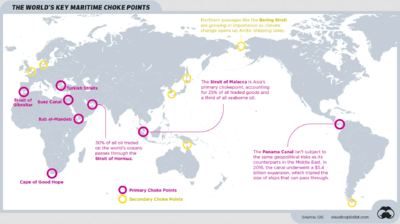Difference between revisions of "Choke point"
Jump to navigation
Jump to search
(start) |
(|description=A chokepoint is a narrow passage or critical area that can be easily defended, allowing a smaller force to control or restrict the movement of a larger enemy.) |
||
| Line 4: | Line 4: | ||
|image_caption= | |image_caption= | ||
|image_width=400px | |image_width=400px | ||
| − | |description= | + | |description=A chokepoint is a narrow passage or critical area that can be easily defended, allowing a smaller force to control or restrict the movement of a larger enemy. |
|constitutes=Military concept | |constitutes=Military concept | ||
}} | }} | ||
Latest revision as of 20:00, 22 October 2024
(Military concept) | |
|---|---|
 | |
| A chokepoint is a narrow passage or critical area that can be easily defended, allowing a smaller force to control or restrict the movement of a larger enemy. |
A choke point in military affairs is a geographical location that is crucial to control because it restricts the flow of troops and/or supplies. It is a narrow passage or a strategic location that can be easily defended or blocked. Choke points can take many forms, including narrow mountain passes, bridges, straits, canals, and other critical infrastructure.[1]
Controlling a choke point can allow a military force to deny access to an enemy or prevent their advance, while losing control of a choke point can lead to a disruption of supply lines and a loss of strategic advantage; as such, they may render superior force of one side irrelevant.
Choke points are often heavily fortified and contested during times of conflict.
Examples
| Page name | Description |
|---|---|
| Strait of Gibraltar | |
| Strait of Hormuz |
Many thanks to our Patrons who cover ~2/3 of our hosting bill. Please join them if you can.